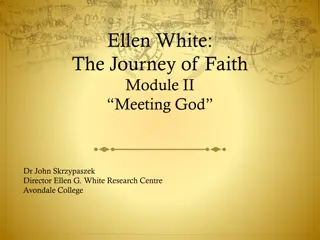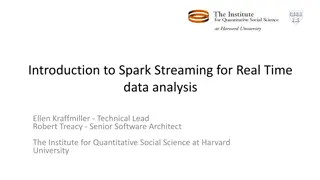
Understanding Universality and Consensus in Distributed Systems
Explore the concepts of universality and consensus in distributed systems, including deterministic objects, Herlihy's consensus hierarchy, 2-consensus objects, and (n,k)-set-consensus. Delve into the implications of these ideas on system scalability and implementation in various processes.
Uploaded on | 1 Views
Download Presentation

Please find below an Image/Link to download the presentation.
The content on the website is provided AS IS for your information and personal use only. It may not be sold, licensed, or shared on other websites without obtaining consent from the author. If you encounter any issues during the download, it is possible that the publisher has removed the file from their server.
You are allowed to download the files provided on this website for personal or commercial use, subject to the condition that they are used lawfully. All files are the property of their respective owners.
The content on the website is provided AS IS for your information and personal use only. It may not be sold, licensed, or shared on other websites without obtaining consent from the author.
E N D
Presentation Transcript
Deterministic Objects: Life Beyond Consensus YEHUDA AFEK, FAITH ELLEN, AND ELI GAFNI PODC 2016
Herlihys Consensus Hierarchy consensus-number(O) = maximum number n such that wait-free consensus among n processes can be solved using only copies of object O and (read/write) registers consensus, LL/SC, compare&swap, 2-consensus, fetch&add, test&set, swap, queue, 2 register, 2-set-consensus, 3-set-consensus, 1
2-consensus object supports: propose(v) for v
2-consensus object supports: propose(v) for v a v1; return a propose(v1)
2-consensus object supports: propose(v) for v a v1; return a return a propose(v1) propose(v2)
2-consensus object supports: propose(v) for v a v1; return a return a propose(v1) propose(v2) propose(v3) return
Universality of n-consensus There is a wait-free implementation of any object using only n-consensus objects and registers in a system of at most n processes.
Universality of n-consensus There is a wait-free implementation of any object using only n-consensus objects and registers in a system of at most n processes. What about in systems with more than n processes?
Universality of n-consensus There is a wait-free implementation of any object using only n-consensus objects and registers in a system of at most n processes. What about in systems of more than n processes? Within level 1, there are an infinite number of incomparable objects.
(n,k)-set-consensus for n > k 1 supports: propose(v) for v first n propose operations each return some proposed value at most k different proposed values are returned all subsequent propose operations return (n,1)-set-consensus is another name for n-consensus (n,k)-set-consensus is nondeterministic when k > 1
Theorem [Borowsky & Gafni 1993, Chaudhuri & Reiners 1996] In a system of n or more processes, an (n,k)-set-consensus object can be implemented from (m,j)-set-consensus objects and registers if and only if k j, n/k m/j, and either k j n/m or k j n/m + n m n/m . For example, a (2k,k)-set-consensus object can be implemented from 2-consensus objects and registers but a (2k+1,k)-set-consensus object cannot.
(4,2)-set-consensus can be implemented from 2-consensus objects PROPOSE(v): f fetch&inc(F) if f 5 then return 1 F C1 g f/2 c propose(v) to Cg return c C2
(4,2)-set-consensus can be implemented from 2-consensus objects PROPOSE(v): f fetch&inc(F) PROPOSE(v1): returns v1 v1 if f 5 then return 2 F C1 g f/2 c propose(v) to Cg return c C2
(4,2)-set-consensus can be implemented from 2-consensus objects PROPOSE(v): f fetch&inc(F) PROPOSE(v1): returns v1 PROPOSE (v2): v1 if f 5 then return 3 F C1 g f/2 c propose(v) to Cg return c C2
(4,2)-set-consensus can be implemented from 2-consensus objects PROPOSE(v): f fetch&inc(F) PROPOSE(v1): returns v1 PROPOSE (v2): PROPOSE(v3): v1 if f 5 then return 4 F C1 g f/2 c propose(v) to Cg return c C2
(4,2)-set-consensus can be implemented from 2-consensus objects PROPOSE(v): f fetch&inc(F) PROPOSE(v1): returns v1 PROPOSE (v2): PROPOSE(v3): PROPOSE (v4): returns v4 v1 if f 5 then return 5 F C1 g f/2 v4 C2 c propose(v) to Cg return c
(4,2)-set-consensus can be implemented from 2-consensus objects PROPOSE(v): f fetch&inc(F) PROPOSE(v1): returns v1 PROPOSE (v2): PROPOSE(v3): returns v4 PROPOSE(v4): returns v4 v1 if f 5 then return 5 F C1 g f/2 v4 C2 c propose(v) to Cg return c
(4,2)-set-consensus can be implemented from 2-consensus objects PROPOSE(v): f fetch&inc(F) PROPOSE(v1): returns v1 PROPOSE (v2): returns v1 PROPOSE(v3): returns v4 PROPOSE(v4): returns v4 v1 if f 5 then return 5 F C1 g f/2 v4 C2 c propose(v) to Cg return c
Theorem [Rachman 1994] For all m 2, there is a non-deterministic object of consensus number m that cannot be implemented from n-consensus objects and registers in a system of 2n + 1 processes, for all n 2.
Theorem [Gafni & Kuznetsov, 2007] Any algorithm using only deterministic objects of consensus numbers at most n can be simulated using n-consensus objects and registers in a system of n+1 processes.
Common2 Conjecture [Afek, Weisberger, & Weisman, 1993] Any deterministic object of consensus number 2 can be implemented from 2-consensus objects and registers in a system with any finite number of processes.
Common2 Conjecture [Afek, Weisberger, & Weisman] Any deterministic object of consensus number 2 can be implemented from 2-consensus objects and registers in a system with any finite number of processes. test&set objects, fetch&add objects, swap objects, and stacks can be implemented from 2-consensus objects and registers in a system with any finite number of processes.
Consensus Hierarchy Conjecture For all m 2, any deterministic object of consensus number m can be implemented from m-consensus objects and registers in a system with any finite number of processes.
Consensus Hierarchy Conjecture For all m 2 any deterministic object of consensus number m can be implemented from m-consensus objects and registers in a system with any finite number of processes.
Theorem For all m 2, there is a deterministic object Om,2 with consensus number m that cannot be implemented from m-consensus objects and registers in a system of 2m + 1 processes.
Theorem For all m 2 and k 2, there are deterministic objects Om,k with consensus number m such that: Om,2 cannot be implemented from m-consensus objects and registers in a system of 2m + 1 processes, Om,k+1 cannot be implemented from Om,k objects and registers in a system of km + m + k processes, and Om,k can be implemented from an Om,k+1 object in a system with any finite number of processes.
Theorem 3-consensus < O3,2 < O3,3< O3,4 < O3,5 < 2-consensus < O2,2 < O2,3< O2,4 < O2,5 <
Theorem 3-consensus O2,3 v O2,2 v 2-consensus
O2,2 object A1A1A2A2A1 supports: suggest(v) for v
O2,2 object A1A1A2A2A1 supports: suggest(v) for v N a1 v1; return a1 suggest(v1)
O2,2 object A1A1A2A2A1 supports: suggest(v) for v N a1 v1; return a1 return a1 suggest(v1) suggest(v2)
O2,2 object A1A1A2A2A1 supports: suggest(v) for v N a1 v1; return a1 return a1 a2 v3; return a2 suggest(v1) suggest(v2) suggest(v3)
O2,2 object A1A1A2A2A1 supports: suggest(v) for v N a1 v1; return a1 return a1 a2 v3; return a2 return a2 suggest(v1) suggest(v2) suggest(v3) suggest(v4)
O2,2 object A1A1A2A2A1 supports: suggest(v) for v N a1 v1; return a1 return a1 a2 v3; return a2 return a2 return a1 suggest(v1) suggest(v2) suggest(v3) suggest(v4) suggest(v5)
O2,2 object A1A1A2A2A1 supports: suggest(v) for v N a1 v1; return a1 return a1 a2 v3; return a2 return a2 return a1 return suggest(v1) suggest(v2) suggest(v3) suggest(v4) suggest(v5) suggest(v6)
Om,k object A1m A2m Ak-1m Akm Ak-1A2 A1 supports: suggest(v) for v N sequential specifications: increment cnt if cnt = (j-1)m+1 for j {1, ,k} then aj v; return aj if (j-1)m + 2 cnt jm for j {1, ,k} then return aj if cnt = km+k-j for j {1, ,k-1} then return aj else return % cnt km+k
Om,k object A1m A2m Ak-1m Akm Ak-1A2 A1 supports: suggest(v) for v N sequential specifications: increment cnt if cnt = (j-1)m+1 for j {1, ,k} then aj v; return aj if (j-1)m + 2 cnt jm for j {1, ,k} then return aj if cnt = km+k-j for j {1, ,k-1} then return aj else return % cnt km+k
Om,k object A1m A2m Ak-1m Akm Ak-1A2 A1 supports: suggest(v) for v N sequential specifications: increment cnt if cnt = (j-1)m+1 for j {1, ,k} then aj v; return aj if (j-1)m + 2 cnt jm for j {1, ,k} then return aj if cnt = km+k-j for j {1, ,k-1} then return aj else return % cnt km+k
Om,k object A1m A2m Ak-1m Akm Ak-1A2 A1 supports: suggest(v) for v N sequential specifications: increment cnt if cnt = (j-1)m+1 for j {1, ,k} then aj v; return aj if (j-1)m + 2 cnt jm for j {1, ,k} then return aj if cnt = km+k-j for j {1, ,k-1} then return aj else return % cnt km+k
Om,k object A1m A2m Ak-1m Akm Ak-1A2 A1 supports: suggest(v) for v N sequential specifications: increment cnt if cnt = (j-1)m+1 for j {1, ,k} then aj v; return aj if (j-1)m + 2 cnt jm for j {1, ,k} then return aj if cnt = km+k-j for j {1, ,k-1} then return aj else return % cnt km+k
Solving m-consensus using an Om,k object A1m A2m Ak-1m Akm Ak-1 A2A1 If m processes each perform suggest once, then they all output a1, the input of the process that performs suggest first.
(m+1)-consensus cannot be solved using only Om,k objects and registers proved using a valency argument
initial bivalent configuration B critical configuration C s1 s0 s2 univalent configurations C1 C0 C2 1 1 0 0
initial bivalent configuration B s0 and s1 must access the same object. They cannot both be reads. critical configuration C s1 s0 univalent configurations C1 C0 s1 s0 1 1 0 0 ?
initial bivalent configuration B s0 cannot be a write. critical configuration C s1 s0 univalent configurations C1 C0 s0 C10 1 1 0 0
initial bivalent configuration B s0, s1 and s2 must all be suggest operations accessing the same O2,2 object. critical configuration C s1 s0 s2 univalent configurations C1 C0 C2 1 1 0 0
critical configuration C s0 = suggest(v0) on O s1 = suggest(v1) on O s2 = suggest(v2) on O O.cnt {1,3} in C s1 s0 s2 univalent configurations C1 C0 C2 1 1 0 0 A1A1A2A2A1
critical configuration C s0 = suggest(v0) on O s1 = suggest(v1) on O s2 = suggest(v2) on O O.cnt {1,3} in C O.cnt 3 in C s1 s0 s2 univalent configurations C1 C0 C2 s0 s1 1 0 C10 C01 A1A1A2A2A1
critical configuration C s0 = suggest(v0) on O s1 = suggest(v1) on O s2 = suggest(v2) on O O.cnt = 1 in C s1 s0 s2 O.a1 = v0 O.cnt = 2 univalent configurations C1 C0 C2 s2 1 0 C12 s0 O.a1 = v1 O.a2 = v0 O.cnt = 4 C120 A1A1A2A2A1
critical configuration C s0 = suggest(v0) on O s1 = suggest(v1) on O s2 = suggest(v2) on O O.cnt = 1 in C s1 s0 s2 univalent configurations C1 C0 C2 s2 s0 is a solo execution by p0 starting from C0 contains 1 suggest on O s0 is a suggest on O 0 1 C12 s0 s1 s0 C120 s2 O.a1 = v1 O.a2 = v0 O.cnt = 5 O.a1 = v0 O.a2 = v1 O.cnt = 5 A1A1A2A2A1 s0 s0






















